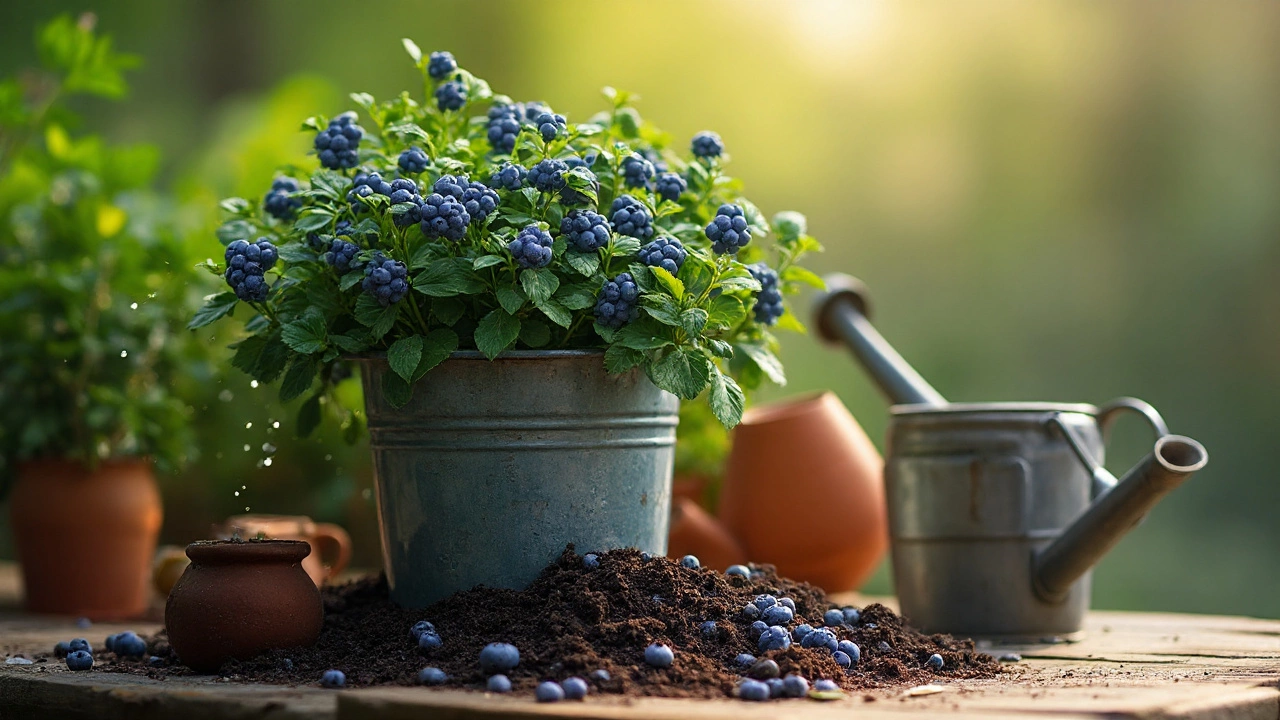If you’ve ever eyed those sweet, blue globes at the grocery store and thought, 'Why can’t I just grow these myself?' you’re not alone. Lots of people want to start their own blueberry patch, but let’s be honest—most of us don’t have acres to play with. Here’s a wild truth: you can grow blueberry bushes in the humble 5 gallon bucket. City, suburb, cramped patio—it doesn’t matter. All you need is the right info, some patience, a little dirt under your nails, and you’ll actually be picking your own berries in a season or two. Sounds too good to be true? Stick with me, and I’ll break down every real thing people run into when trying to turn a regular old bucket into a fruit-producing machine.
Why Blueberries and Buckets Actually Work Together
On the surface, blueberries might seem picky. You hear they hate bad soil, love acid, and get moody if their roots are squished. Despite all that, these plants actually do great in containers—sometimes even better than in your backyard’s stubborn clay. A 5 gallon bucket gives you total control. You pick the soil, water how you want, and even move the plant around like you’re playing plant Tetris to find better sun spots. Got late frost coming in? Just scoot the bucket under cover. Pests digging up your garden bed? Too bad, berries are safe up in a portable container.
Some commercial growers use massive pots for blueberries but the everyday gardener has turned to standard 5 gallon buckets because they’re cheap, easy to carry, and usually lying around already. And get this—the root ball of a blueberry shrub doesn't get much bigger than a bucket if you use dwarf or half-high varieties. Even older cultivars settle in fine for years before outgrowing their first container. A guy in Oregon shared he pulled off six pounds of berries from a single bucket-grown plant last summer. That’s breakfast all through berry season.
There's also real science here. Blueberries are shallow-rooted and dislike waterlogged soil, which means buckets, with good drainage, let you avoid the root rot and blight issues that foil newcomers. When you nail down the right soil mix (more on that soon), you just keep your bucket over the years, refresh soil each spring, and watch it come back with more fruit every year. Plus, bucket growing is made for renters or small-space gardeners. You don’t have to dig up lawn or break rental agreements.
Setting Up: Pick the Right Bucket and Get the Soil Mix Right
Not all buckets are created equal when it comes to growing berries. First rule: make sure you’re using food-safe plastic—don’t grab an old paint bucket or mystery tub from the garage. Look for the HDPE '2' mark if in doubt. Drill half a dozen drain holes in the bottom to keep roots from drowning in a rainstorm. If you’re worried about mess, set the bucket on a tray, or on bricks for a little lift-off.
Now, forget about regular garden soil. Blueberries need stuff that’s light, acidic, and a bit on the lean side for nutrients. Here’s my favorite go-to recipe for blueberry bucket mix. Blend equal parts peat moss (or coconut coir if you don’t like peat), pine bark fines (not big bark chunks), and perlite. Add a handful of good compost for a little nutrition. To make it acidic, toss in a cup of elemental sulfur per bucket, and test with a soil pH meter until you reach somewhere between 4.5 and 5.5 pH. If you want to go full pro, look for bagged 'Azalea, Camellia & Rhododendron' soil, which is acid-based and works for blueberries by default.
Keep in mind, blueberries are not heavy feeders at first, so skip the harsh chemical fertilizers. Go with organic, slow-release acidic fertilizers or just mix in a scoop of blood meal or cottonseed meal each spring. Here’s a quick table comparing soil options and pH ranges perfect for blueberries:
| Soil Ingredient | Purpose | Recommended pH |
|---|---|---|
| Peat Moss | Acidifies & keeps soil airy | 4.5-5.5 |
| Pine Bark Fines | Adds texture, keeps roots cool | 4.5-5.5 |
| Perlite | Improves drainage | N/A |
| Compost | Adds light nutrients | 6.0 (balance in mix) |
| Elemental Sulfur | Boosts acidity | Adjusts pH down |
Mix everything up in a wheelbarrow and fill your bucket, leaving an inch or so at the rim for watering. Now you’re ready for the plant.

Choosing Blueberry Varieties That Actually Fit (and Fruit!)
Sometimes people grab any old blueberry shrub at the nursery and hope for the best, but in a bucket, size and chill hours matter. Lowbush types (like wild Maine blueberries) are too sprawling for buckets and want to run underground. Instead, you want compact varieties—called half-highs or dwarf bush types. These top out at 2-3 feet and still give a good crop.
'Top Hat', 'Jelly Bean', and 'Sunshine Blue' are stars for the bucket crowd. They’re compact, tolerate warmer or cooler climates, and don’t punish you if you forget one watering. Got just one bucket? 'Sunshine Blue' is even self-pollinating, so you’ll get berries with just a single plant. If you’re a little obsessive about fruit quality, double up on two different varieties for cross-pollination—it bumps fruit set by 30% or more, according to research from North Carolina State University. You’ll taste the difference and see fuller clusters.
Know your local climate, though. Northern highbush blueberries need 800+ chill hours and won’t bear as well in southern heat, while southern half-highs can cruise through a mild winter. Keep an eye on the 'chill hours' requirements for your zone; if your winters are hot, look for 'Misty', 'Legacy', or 'Bountiful Blue'. The incredible thing about buckets—you can bring the plant indoors or into a garage in harsh weather, stretching the growing season and even protecting from surprise frost or hail.
Here’s a short variety breakdown:
- Top Hat (Dwarf Highbush): Perfect for small spaces, about 18-24 inches tall, and loads of flavor. Hardy to Zone 3.
- Sunshine Blue: Semi-dwarf, self-pollinating, cold/heat tolerant, only 3 feet mature height.
- Jelly Bean: Brilliant red winter stems, compact size, and sweet berries—tough in most climate zones.
- Bountiful Blue: Mild chill hours, beautiful blue-green leaves, solid berry size.
It’s not just about size. Some of these types even double as pretty porch plants with their red fall leaves or pinkish blossoms. You get beauty and breakfast in one bucket.
Daily Blueberry Bucket Care: Sun, Water, and Fertilizer Secrets
If you set it and forget it, you’ll end up with dried twigs or sad, leafless stems. Blueberries need a bit of TLC, but nothing that’ll stress you out. First—sun. These plants need about 6 hours of direct sunlight daily. Too little sun and you'll be lucky to get a handful of berries. Too much intense heat (say, 95°F+) and they’ll wilt, so scoot the bucket to partial shade in the afternoons during scorching summer days.
Watering might seem dull, but here’s the deal: blueberry roots are close to the surface and hate to dry out or soak for days. You’re aiming for moist but not soggy soil. Slide a finger into the mix—if it’s dry an inch down, water until you see drips from the bottom. Usually, that’s 1-2 inches a week, just a little more in peak summer heat. Set up drip irrigation or a simple soaker hose if you want to go high-tech, but hand-watering works just fine if you keep up with it.
Fertilizer is pretty easy. In spring, when you see leaf buds returning, sprinkle a bit of granular acidic fertilizer (like Holly-tone or Espoma 'Berry-tone') on the surface. Don’t overdo it. Too much nitrogen will give you giant leaves but barely any fruit. People often miss one big trick: mulch. Add an inch of pine needles, bark, or sawdust to the surface to hold moisture, keep weeds out, and feed soil microbes. This keeps the roots cool and cut back on summertime watering, especially if your bucket sits on hot concrete or decking.
Buckets heat up more than garden beds. In blazing sun, heat builds up at the roots—even if the leaves look fine. You can shade the side of your bucket with an old towel or wrap, or just move it to a part-day-shade spot starting in mid-July. The beauty of containers is you play 'move the plant' instead of fighting nature.
If you want stats, here they are:
| Care Action | Best Practice | Common Mistake |
|---|---|---|
| Sunlight | 6+ hours/day | Partial shade all day |
| Watering | Moist, never soggy | Letting soil dry out completely |
| Fertilizer | Spring, acidic types | Using regular lawn fertilizer |
| Mulch | Pine needles or bark | Skipping altogether |
Pest control? Lucky for you, blueberries are rarely bug targets in a bucket. Occasionally, caterpillars or aphids show up, but a good blast of water or a bit of neem oil clears things up fast. If you live in bird territory, toss a lightweight net over the plant after fruit sets or you’ll be feeding the neighborhood robins instead of your own family.

What to Expect: Timeline, Harvest, and Long-Term Upkeep
Let’s talk patience. Blueberries don’t pay off in a week—these guys want a season or more before you get a snack. Expect your first real harvest in year 2 or 3 after planting a small nursery shrub. The first summer, you’ll likely see just a handful of flowers and berries, especially if you pinch off early blooms to let roots get strong. Don’t sweat it—invest the time up front and you’ll be awash in fruit in a year or two.
From mid-May to July, depending on the variety, you’ll see berries ripen in batches. Check for deep blue color all over and a slight give to the fruit; green-tipped or red berries are sour and not ripe yet. Berries hang on the plant a day or two after they’re blue, which actually makes flavor sweeter. Pick gently—these fruits bruise easily. Use a shallow bowl, not a deep basket, and store your haul in the fridge. Most homegrown blueberries last about a week chilled, and they freeze incredibly well—put them straight on a baking sheet, then transfer frozen berries to bags for later smoothies or pancakes.
Each early spring, top up your bucket with a little fresh acidic mix, sprinkle new fertilizer, and renew mulch. Replace the whole soil every 3-4 years to keep the plant thriving; roots outgrow the mix and drain holes will slowly clog over time. If your bush is suddenly struggling—smaller leaves, less fruit, droopy stems—it’s a sign it wants a bigger home. You can pot it up to a 10 gallon container or even dig a small garden bed when you finally have the space. Until then, keep up your routine care and enjoy those surprise first flowers each spring.
Want to speed growth or boost the berry haul? Here’s a bucket-growing secret most people miss: after the first fall frost, leave the bucket outdoors or store it in an unheated garage for 6-8 weeks. Blueberries need cold dormancy to fruit well, but avoid freezing them solid for weeks. When spring warmth returns, your plant will come roaring back with twice the vigor.
The feeling of picking a sun-warmed berry, grown from scratch in nothing but a 5 gallon bucket, is pure magic. The trick isn’t huge land or expensive gear—it’s care, good soil, and knowing exactly how to tweak conditions. When neighbors ask how you did it, just point to your bucket and smile. They’ll never believe it’s that easy until they try for themselves.

